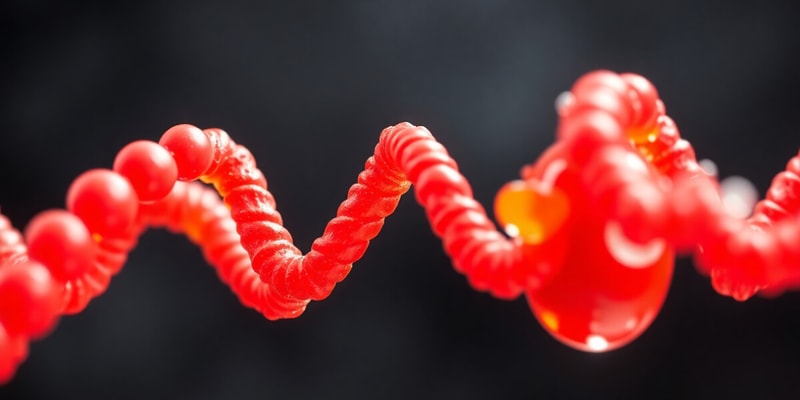Podcast
Questions and Answers
Calculate the value of ΔS° using the equation ΔG = ΔH - TΔS and the given values for ATP hydrolysis at 37 °C.
Calculate the value of ΔS° using the equation ΔG = ΔH - TΔS and the given values for ATP hydrolysis at 37 °C.
ΔS° = 34.0 J mol−1.
Discuss the significance of the negative ΔG value for ATP hydrolysis.
Discuss the significance of the negative ΔG value for ATP hydrolysis.
A negative ΔG indicates that the reaction is spontaneous and energetically favorable, promoting the conversion of ATP to ADP and Pi.
Given ΔH° = -20.1 kJ mol−1 for ATP hydrolysis, what does this indicate about the energy change in the reaction?
Given ΔH° = -20.1 kJ mol−1 for ATP hydrolysis, what does this indicate about the energy change in the reaction?
It indicates that the reaction is exothermic, releasing energy.
What does a positive ΔS° value indicate about the disorder associated with ATP hydrolysis?
What does a positive ΔS° value indicate about the disorder associated with ATP hydrolysis?
Signup and view all the answers
Calculate the temperature above which the unfolding of a protein becomes spontaneous, given ΔH° = 250.8 kJ mol−1 and ΔS° = 752 J K−1 mol−1.
Calculate the temperature above which the unfolding of a protein becomes spontaneous, given ΔH° = 250.8 kJ mol−1 and ΔS° = 752 J K−1 mol−1.
Signup and view all the answers
Explain the significance of ΔH° = 250.8 kJ mol−1 for the unfolding of a protein.
Explain the significance of ΔH° = 250.8 kJ mol−1 for the unfolding of a protein.
Signup and view all the answers
Discuss the implications of ΔS° = 752 J K−1 mol−1 for the unfolding of a protein.
Discuss the implications of ΔS° = 752 J K−1 mol−1 for the unfolding of a protein.
Signup and view all the answers
What are the implications of ΔG being positive for the reverse process of protein unfolding?
What are the implications of ΔG being positive for the reverse process of protein unfolding?
Signup and view all the answers
Study Notes
Gibbs Free Energy (G)
- Gibbs Free Energy (G) is a thermodynamic potential that can be used to predict the spontaneity of a process.
- A process is spontaneous when G < 0 (negative Gibbs Free Energy).
- The formula for Gibbs Free Energy is:
- G = H - TS
- Where G is Gibbs Free Energy, H is Enthalpy, T is temperature in Kelvin, and S is Entropy.
ATP Hydrolysis
- ATP hydrolysis is a key reaction in the transfer of energy in biochemical reaction.
- In ATP Hydrolysis:
- ATP is broken down into ADP and inorganic phosphate (Pi).
- The enthalpy change (ΔH) is negative indicating the reaction is exothermic.
- The entropy change is positive as the reaction produces more molecules than it consumes.
- Gibbs Free Energy (ΔG) is negative for ATP hydrolysis, making the reaction spontaneous.
Unfolding of a Protein
- The unfolding of a protein occurs when it transitions from a folded (active) to unfolded (inactive) state.
- The process is favorable (spontaneous) when Gibbs Free Energy (ΔG)<0.
- Spontaneous unfolding of a protein requires a temperature that is above the proteins melting temperature.
- The melting temperature is the temperature at which the change in Gibbs Free Energy (ΔG)=0.
Studying That Suits You
Use AI to generate personalized quizzes and flashcards to suit your learning preferences.
Related Documents
Description
Explore the concepts of Gibbs Free Energy and ATP hydrolysis in this quiz. Understand how Gibbs Free Energy predicts spontaneity in reactions, as well as the importance of ATP hydrolysis in energy transfer. Evaluate the thermodynamic principles behind protein unfolding and how they relate to these processes.




